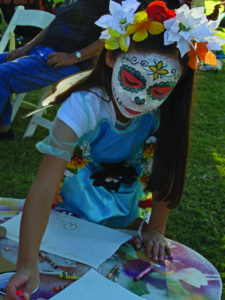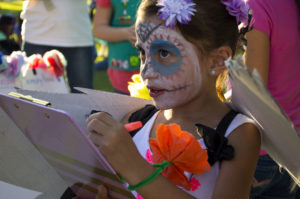By Phoebe Stevens
El Independiente

Children with painted faces run around Armory Park in homemade costumes, while their families spread out across the plush green lawn and relax beneath the sun’s warmth. From the air that buzzes with laughter and chatter, most people would not assume that the event being held that day had anything to do with death.
But mortality is one of the main themes at the Procession of Little Angels. It’s a family-oriented extension of the annual All Souls Procession. It is an event held every year to provide a safe and kid-friendly space for children to explore and understand the concepts of death, grief and loss, which are all present at All Souls.
“While you can find those elements in the All Souls Procession, because Little Angels is a kid-driven event, there’s this sense of the joy of being alive,” says event director Jhon Sanders. The “very festive, very playful” event prevents death from being a somber topic, and allows children to conceptualize it in the ways that come naturally to them.
Children’s curiosity is one of the youthful instincts Little Angels plays upon to help them understand death. Every year at the Procession of Little Angels, people and their families can erect personal altars along the path that winds around Armory Park. Children gaze out from framed photographs, laughing in the arms of family members, and votive candles burn to memorialize lives that have since passed. Golden, fuschia and tomato-red flowers frame poems and handwritten prayers.
While the personal altars are an opportunity to pay homage to deceased loved ones, Sanders says they also become “focal points of conversation.” As children and their families tour the altars, the kids can ask their questions and those attending the altars have the opportunity to share their stories.
It is a way for children to understand the universality of death and for people to come together and “recognize our shared humanity and mortality,” Sanders says.

The personal altars are inspired by Dia de los Muertos traditions, in which people leave out foods and gifts for their deceased relatives as a way of remembering them and honoring their lives.
For Nallali Vargas, attending Little Angels with her daughters is a way for her to share that part of her culture.
“It was never something that was scary to me, so [my daughters] grow up knowing things do die, but you get to see them again,” she says.
The Stories that Soar! program also helps children engage with their curiosities about concepts like death. Stories that Soar! is a Literacy Connects program that takes compositions written by children and turns them into live-action performance.
Because the culture at large doesn’t offer many opportunities to talk about death or loss, “children often process those thoughts through their writing” or other creative expressions, says Literacy Connects artistic director Sharon O’Brien.
This year one of the stories performed at Little Angels, “Flowers,” was about a child’s garden, which grew and flourished until one day all of the flowers died.
The child-author wrote that the mother said, “It’s okay, because they are going to drop their seeds and grow again.” The Stories that Soar! performance of this story illustrated how this child perceived the life cycle.
Sanders says that creative expression is a way to tease out and confront feelings we don’t take the time to think about in our day-to-day life, which is what makes costuming another important element in
the Procession of Little Angels. Children are encouraged to wear homemade costumes and workshops are held in the weeks leading up to Little Angels to aid them in making them.

In addition to making costumes, decorating wings is one of the most iconic art activities done at Little Angels, according to Sanders. The wings, pre-cut by Sanders and other volunteers in the community, are all different styles. From jetpacks to lightning bolts, from dragons to bat wings, there is a pair to suit every child.
After the children pick their wings, they can write names or messages on them, an activity that again tunes into their creative expression. According to Sanders, kids in the past have brought photos of people who have passed on to tape to the wings.
“They make them into sort of a ritual object for the Procession to memorialize,” he says. Other times, “it’s just as simple as making something beautiful.”
By looking at death through the eyes of children, the Procession of Little Angels reminds adults too of the beauty of life.
Sanders says, “It’s a chance for everybody to step out of their ordinary routines and remember what’s important in life, and to do that together as a community, which is really the key thing about Little Angels.”
Phoebe Stevens is a reporter for El Independiente, a publication from the School of Journalism with the University of Arizona. Contact her at [email protected].

